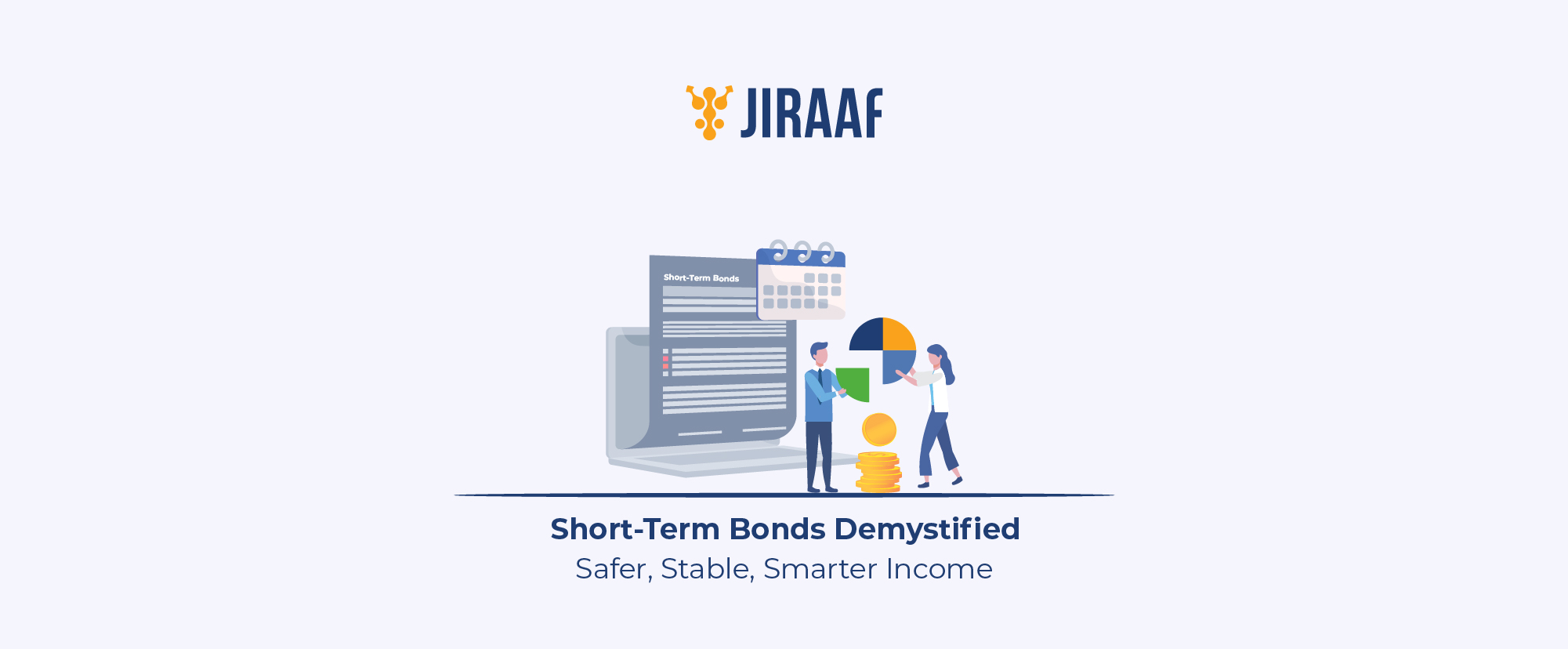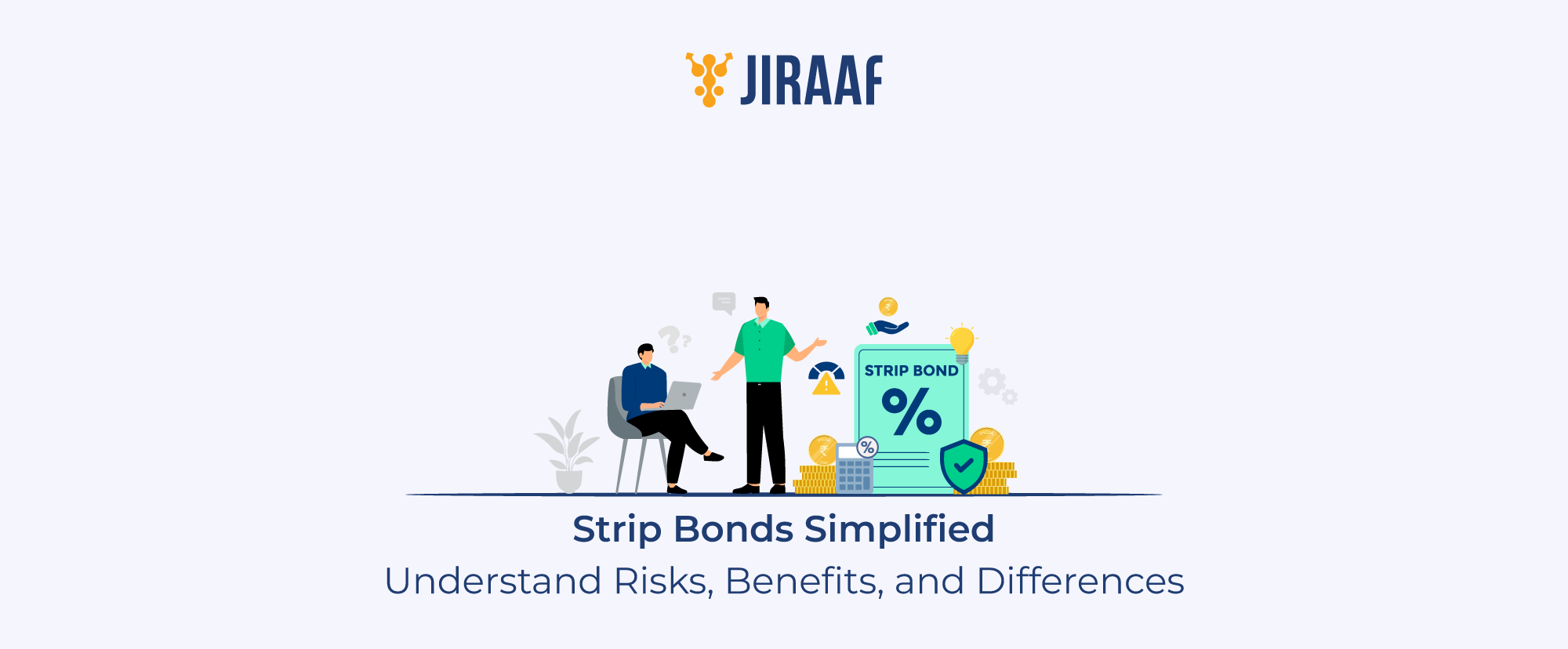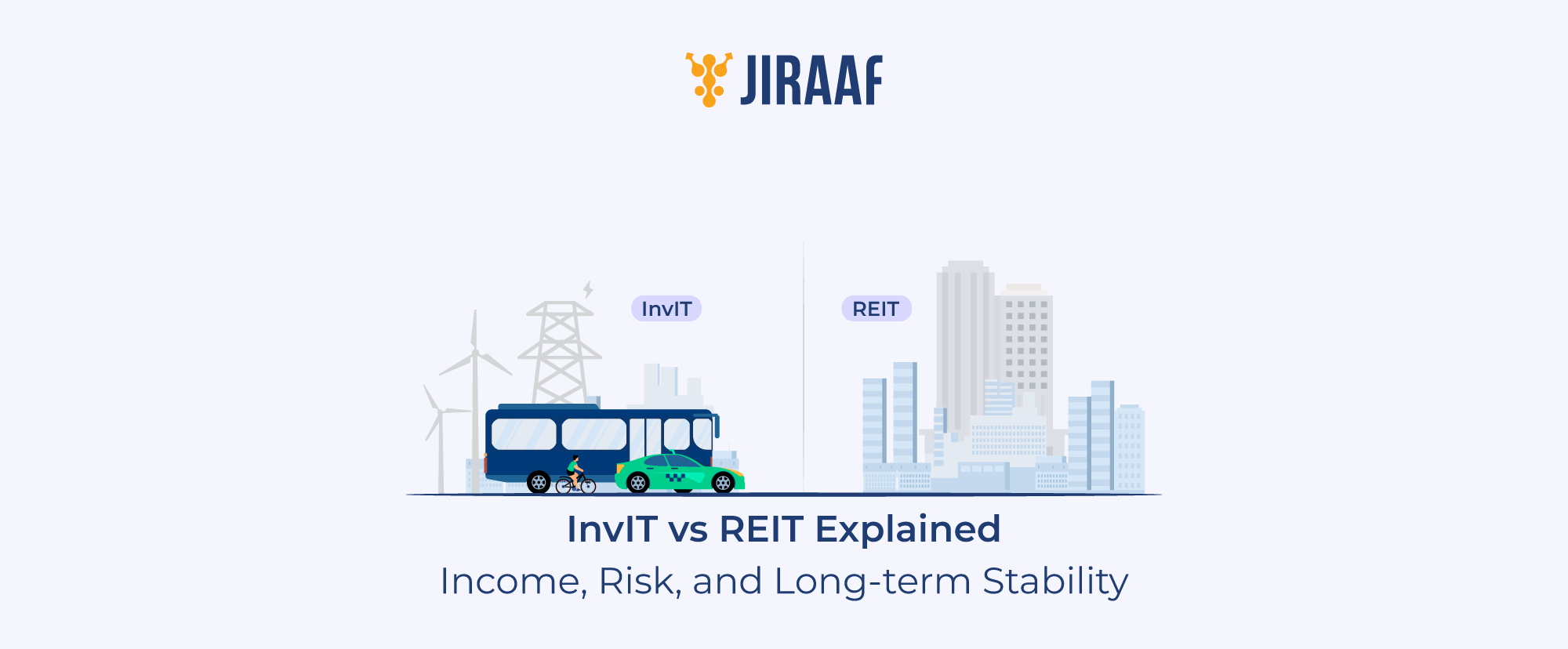Imagine you are planning to buy a house in 4 years and already have ₹10 lakh saved up. You are in a position where you need this money to grow but can’t afford to put it in a volatile asset class like equity. Additionally, placing that money in traditional fixed deposits will further lock your money away, yielding returns that barely keep pace with inflation. In this case, you need to park your money in a place that is safer than equity and offers a higher return than FDs at the same time.
This is precisely where a fixed-income instrument, such as a short-term bond, is considered an appropriate option. These highly liquid, low-risk instruments typically offer returns of 5-15% with an investment tenure of one to three years, or up to five years in some cases. Unlike equity investments, short-term bonds provide predictable interest payment patterns that help you plan your financial future with confidence.
In this blog, we will discuss what short-term bonds are, their types, who should invest in them, and much more.
What are Short-Term Bonds?
Short-term bonds are debt securities that are highly liquid and considered less risky when compared to equity markets. These bonds typically mature within one to three years. Due to brief investment tenure, short-term bonds are less exposed to market volatility and interest rate fluctuations.
Short-term bonds are issued by organizations such as governments, companies, or financial institutions. These organizations issue these bonds to meet their short-term capital requirements.
In simple words, it’s a loan you provide to organizations for a predetermined period while earning fixed interest payments along the way. As promised, the issuer must return your principal amount on the maturity date.
Short-term bonds are also actively traded on the secondary markets, offering high liquidity. These bonds are ideal for investors who want to invest and access their funds within the next few years.
Some types of short-term bonds include commercial papers (CPs), certificates of deposit (CDs), treasury bills (T-bills), and corporate bonds with shorter tenures. Let us take a deeper look at each type.
Types of Short-Term Bonds You Can Invest In
The short-term bond market in India comprises of two types of bonds – government bonds and corporate bonds. Here are some of the common short-term bond options available in India.
- Treasury Bills (T-Bills): T-Bills are government-issued securities with investment tenures of 91, 182, and 364 days. These securities are backed by the government, offering a sovereign guarantee. T-Bills generally offer yields ranging from 5.48% to 6.58%.
- Commercial Papers (CPs): Commercial papers are unsecured promissory notes issued by corporations for periods ranging from 7 days to 1 year. These short-term bonds typically offer yields between 7% to 9% and are issued by companies with strong credit ratings for funding their working capital requirements.
- Certificates of Deposit (CDs): Certificates of Deposit are debt instruments issued by banks and financial institutions for tenures ranging from 7 days to 1 year. CDs offer slightly higher yields ranging from 6.2% to 7%.
- Corporate Bonds (Short tenure): Short-term corporate bonds are debt securities issued by companies having investment tenure of one and three years. These bonds offer the highest yields among short-term bonds, ranging from 8% to 15% based on issuer credit ratings.
- Government Securities (Short-term): G-secs refer to the securities issued by the central and state governments of India. These bonds provide yields between 6% to 7% with sovereign backing.
Government vs Corporate Bonds
Government short-term bonds are primarily dominated by Treasury Bills (T-Bills) with 91, 182, and 364 days of investment tenure. T-Bills are one of the safest short-term debt securities with a sovereign guarantee.
On the other hand, corporate short-term bonds offer higher yields when compared to T-Bills. These bonds have to undergo rigorous credit assessment by agencies like CRISIL, ICRA, and CARE before getting listed on platforms like Jiraaf.
Short-term corporate bonds offer diverse options when compared to government bonds. The risk of default in these bonds is minimal for companies that are rated AAA to BBB.
High-yield Short-term Bonds Explained
High-yield short-term bonds are fixed-income instruments with their yields ranging up to 15% with shorter maturity periods. These securities are issued by organizations with A- to BBB+ credit ratings.
High-yield short-term bonds are highly liquid in the secondary markets. These bonds solve the critical pain points faced by investors by being more stable than equity markets and offering more returns than traditional FDs at the same time.
Platforms like Jiraaf curate the listed high-yield short-term bonds through rigorous due diligence processes such as examining issuer credibility, business model sustainability, and repayment capacity before registering these securities on the platform.
With their combination of attractive yields and relatively brief maturities, short-term bonds are ideal for investors looking for goal-based investing. But before investing in these bonds, investors must weigh all the pros and cons and analyze how short-term bonds match their investment journey.
Risks and Returns of Short-Term Bonds
- Rewards of Investing in Short-term Bonds: Short-term bonds generate higher returns ranging from 8% to 15% in the case of corporate issues. This far outpaces the traditional fixed deposit rates. These bonds provide an ideal pathway for investors looking to park their money for one to three years to achieve their near-term financial goals such as vacation, bike/car purchase, etc. The quick capital turnover nature of short-term bonds makes them less susceptible to interest rate changes and market volatility.
- Associated Risk Factors: Despite their stable and conservative nature, short-term bonds carry two primary risks: credit risk and interest rate risk. Let us understand them deeply.
Understanding Credit Risk and Interest Rate Risk
Credit risk is the possibility of a bond issuer defaulting on their payment obligations. This risk depends on the bond issuer’s financial health, business model, and credit rating. Investment grade bonds (AAA to BBB-) carry minimal credit risk while offering growth.
On the other hand, interest rate risk comes into the picture whenever the short-term bonds are affected due to interest rate changes. For example, if you invest in a 2-year bond at 9% and market rates rise to 11%, your bond becomes less attractive.
Average Yields and What to Expect
Based on recent market data and reference sources, AAA-rated corporate short-term bonds typically yield 7% to 9.5%, providing a significant premium over risk-free government securities while maintaining high credit quality. Furthermore, AA-rated bonds have yields between 9.5% to 11%, representing a sweet spot for conservative investors seeking enhanced returns with manageable risk.
A to BBB- rated short-term bonds, often categorized as high-yield short-term bonds, provide yields ranging from 10% to 15%.
Historical performance shows that short-term bonds have consistently outperformed fixed deposits by 50-300 basis points while maintaining capital stability. Over the past three years, well-diversified short-term bond portfolios have delivered average returns of 7.5% to 10.2%, significantly outpacing inflation and providing real wealth creation for investors.
Now, having established the risk-return profile and expected yields from short-term bonds, the next important step for investors is to evaluate the tax implications on these bonds to accurately assess their post-tax returns and overall investment efficiency.
Taxation on Short-Term Bonds in India
Short-term bonds are liable for taxes on both interest and capital gains. The tax treatment varies by bond type and the holding period of an individual. Interest received from these bonds is classified as “Income from Other Sources” and taxed according to the investor’s slab rate (5% to 30% plus surcharge and cess). A 10% TDS is also deducted from interest payments, which you can claim as credit when filing your ITR.
When an investor sells listed bonds before maturity, the gains will be taxed as short-term capital gains (STCG) at slab rates. On the other hand, bonds held over 12 months are taxed with long-term capital gains (LTCG) tax at 12.5% without indexation. For example, selling ₹1 lakh of bonds after 15 months for ₹1.08 lakh incurs ₹1,000 LTCG tax.
Since most short-term bonds are held to maturity, investors rarely incur capital gains tax.
Tax-efficient Investing Tips
- Hold Until Maturity: Avoid capital gains tax by keeping bonds to maturity.
- Time Interest Receipts: Plan interest payments in years when your income is lower to reduce tax liability.
- Use HUF or Family Members: High-income investors can invest via HUF or family members in lower tax brackets.
- Harvest Losses: If some bonds trade at a loss, sell to offset other capital gains.
Why Invest in Short-Term Bonds?
Short-term bonds offer the ideal investment opportunities for investors who want an inflation-beating and stable investment to park their money for one to three years. These bonds are highly liquid and can be sold in the secondary markets during market hours, so your capital doesn’t get locked.
Goal-based Investing
Short-term bonds are best suited for goal-based investing, where the investment horizon and financial objectives are clearly defined. Their quick turnover in one to three years range allows investors to align investment duration with the timeline of their goals, such as buying a home, funding education, or building an emergency fund.
Short-term bonds offer fixed and certain financial gains, giving investors’ confidence in achieving their target corpus.
Benefits over Fixed Deposits
Short-term bonds offer multiple benefits over traditional FDs. While FDs provide guaranteed returns, they typically range from 7% to 8.15% annually in 2025 for most major banks and institutions. These returns are barely able to keep pace with the annual inflation. On the other hand, short-term bonds deliver higher yields ranging from 8% to 15%.
Unlike traditional FDs, where premature withdrawal attracts penalties, short-term bonds can be sold in secondary markets, giving you an instant option to liquidate your investment.
Ideal for Low-risk Portfolios
Short-term bonds are ideal securities for conservative investors. These fixed-income securities provide stability and income generation without the volatility associated with equity markets.
If you are someone who believes short-term bonds can provide value to your portfolio, you can invest in these bonds online by following the steps mentioned below. Let us take a look.
How to Buy Short-Term Bonds in India with Jiraaf
SEBI’s recent OBPP regulations have democratized the way retail investors buy bonds online. Here is a simple three step process on how to buy short-term bonds in India with Jiraaf.
1. Complete Paperless KYC Online: Begin by completing digital KYC using your Aadhar and PAN details. The entire process will take less than 15 minutes. Jiraaf ensures complete data security while complying with SEBI and RBI regulations for investor verification.
2. Select From Curated Opportunities: Jiraaf curates short-term bonds based on rigorous credit evaluation. You can choose any listed short-term bond that best meets your financial goal.

Tip: You can also check out Jiraaf’s bond analyser tool to compare multiple bonds at once.
3. Complete Payment and Receive Securities: Once you have chosen to invest in a bond, you just have to transfer funds through secure payment gateways to SEBI-regulated clearing corporations. Once the payment is made, securities will be directly credited into your demat account.
Key Things to Look for Before Investing
Here are five things to consider before investing in short-term bonds.
- Personal Financial Goals: Define specific requirements of your financial goals. Match the bond’s maturity with your goal timelines to avoid premature exits.
- Risk Appetite Assessment: Understand your comfort level with credit risk versus return expectations. AAA-rated bonds offer lower yields but higher safety, while BBB-rated bonds provide higher returns with moderate risk when compared to AAA rated bonds.
- Credit-Rating Analysis: Examine issuer credit ratings from agencies like CRISIL, ICRA, and CARE. Focus on rating stability, recent changes, and outlook assessments. Avoid bonds from issuers with negative rating watches or recent downgrades.
- Security Features: Evaluate asset backing, guarantees, or other security structures that protect your investment. Secured bonds typically offer lower yields but provide additional safety nets in case of issuer distress.
- Interest Payout Schedule: Choose between monthly, quarterly, or cumulative interest options based on your cash flow needs.
Conclusion
For investors chasing near-term goals, whether it’s buying a home, building an emergency fund, or planning a big purchase, short-term bonds offer a sweet spot between safety and growth. They provide predictable returns, higher liquidity, and lower volatility compared to equities, making them ideal for anyone who wants their money to work harder without taking unnecessary risks.
With SEBI’s online bond platforms like Jiraaf simplifying access, investors can now build customized short-term debt portfolios with just a few clicks.
The key is to match your bond choices to your personal timelines and risk appetite. When done right, short-term bonds can transform from being just another fixed-income option into a powerful enabler of your financial milestones.









